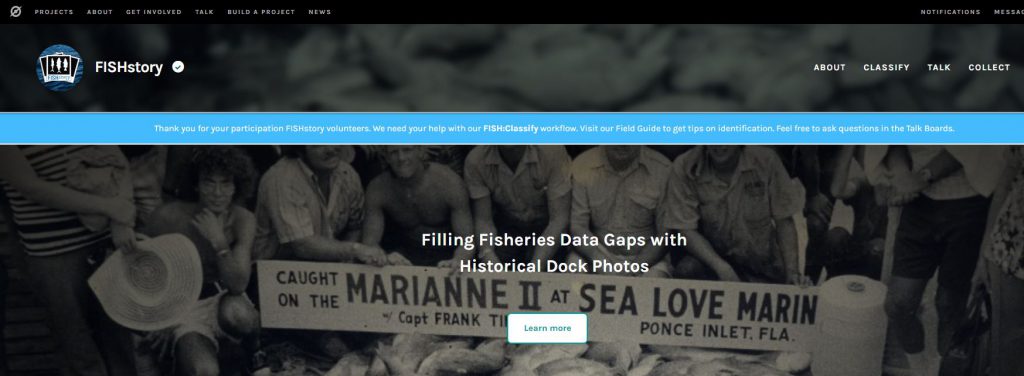by Heather Kent | Feb 12, 2021
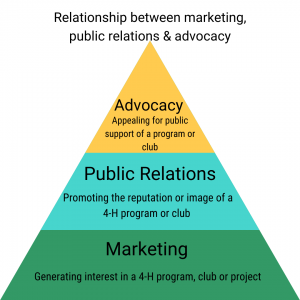
Marketing provides a foundation for public relations and advocacy. All three actions have implications for volunteers, parents and members.
The terms marketing, public relations and advocacy are often used interchangeably, but they are not the same. However, all three of these actions support our 4-H clubs and projects. Over the next couple of weeks, we will break down each term and talk about how 4-H volunteers and members can use these actions to benefit their clubs and projects.
Marketing is simply the act of generating interest in your 4-H club or project. It can be through word of mouth, media, or displays at community events or businesses. Public relations goes a step further than just generating interest; it is about promoting a club or program’s reputation and image. Advocacy is the most advanced action of the three, and it is the act of using a program’s reputation and value to generate public and even monetary support.
At first glance, you might think that marketing is the responsibility of the 4-H agent, and it is (at least for the total 4-H program). However, marketing has important implications at the club and individual member levels that volunteers, parents and youth should consider:
- Marketing the Club- recruit additional members and volunteers
- Marketing the Project- generate interest in project sales or secure a buyer for a market animal project
- Marketing your Skills- use 4-H experiences to market workforce skills for your resumé and prepare for school, scholarship or job interviews.
Marketing the 4-H Club
In order to be chartered, clubs must have a minimum of five youth from at least two different families. Marketing is a great way to recruit members for new clubs, but sometimes club rosters may dwindle due to circumstances beyond the volunteer’s or parent’s control such as a change in job, move to a different community, schedule change or even a change in school. A static display at the local library or school or even a press release or social media post can generate new members for your club.
Another reason why volunteers may want to engage in marketing relates to diversity and inclusion. 4-H is a three-way partnership between the federal, state and local governments. As such, 4-H is a non-discriminatory program and annually, 4-H programs must provide evidence that their programs are open to all. If your club is not representative of your community’s demographic make-up, your 4-H agent may ask you to conduct “All Reasonable Efforts.” This is a process to verify that the club has made efforts to engage youth who are representative of their community. Your local 4-H agent can help you identify opportunities to market your club and record those efforts on the “All Reasonable Efforts” checklist.
Marketing the 4-H Project
One of the great things about 4-H is it is a safe place for youth to learn about business and entrepreneurship. Many (if not most) 4-H projects offer opportunities for youth to learn financial literacy skills. Whether it is selling an animal for food, or so that other youth can start a herd or flock, there are opportunities for youth to market their project to generate sales or secure a buyer for their animal. Check out this website from Penn State on tips for identifying potential buyers, drafting a letter to buyers and how to prepare your personal sales pitch.
Marketing Your Skills
To be prepared for work and life, 4-H youth need to learn how to present themselves to potential employers. It can be hard to get that first job or internship when you have no previous experience. Use your 4-H project, leadership and citizenship experiences! The 4-H “Marketing You” worksheet can help you identify marketable workforce skills you have learning through your 4-H experiences to make you a competitive applicant for a job, scholarship or entry into college or trade school. The Florida 4-H Next Stop Job program walks you through how to:
by Allison Leo | Dec 30, 2020
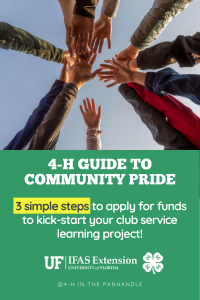 4-H clubs and individual members of all ages are eligible to participate in a Community Pride Project. This project is a great way to directly impact your community through a special service learning project of your choice. Service learning is an experiential learning activity and you can read more about what service learning is here or here.
4-H clubs and individual members of all ages are eligible to participate in a Community Pride Project. This project is a great way to directly impact your community through a special service learning project of your choice. Service learning is an experiential learning activity and you can read more about what service learning is here or here.
Community Pride is a service learning program. The objectives of the Community Pride Program are:
- Youth learn about their community and the impact the community has on their lives.
- Youth understand how to relate to their community as individuals and through group cooperation so they can effectively work in community activities, programs, and organizations.
- Youth develop skills and knowledge in community leadership.
- Youth gain experience carrying out community projects to improve their environment.
- Youth develop an interest in and love for their community.
How Does Community Pride Work?
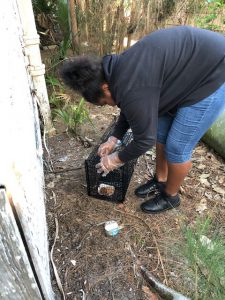
4-H member in Martin County sets up a trap for feral cats as part of the Community Pride Project Photo by: Natalie Parkell
During the project a community issue is identified, a service project is selected, a plan is implemented by the group, and reflection and reporting take place.
What types of projects can you complete through the Community Pride Grant?
That is up to you! The best thing about the project is that you get to select your service learning project based on you community’s need. There are five main steps to the Community Pride Project and those are listed in detail below. Martin County 4-H members received a Community Pride Grant to help combat feral cats in their neighborhood and you can read more about it here. Broward County 4-H members have completed a variety of projects through this program and you can see the variety of projects here. If you would like to receive a Community Pride Grant to complete a service project of your choice, follow the steps below and contact your county 4-H Agent for assistance.
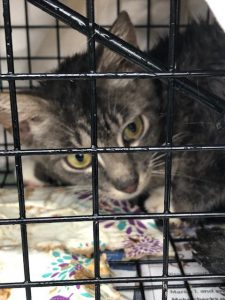
One of the cats that was captured, neutered, and released as part of Martin County 4-H’s Community Pride Project combating feral cats. Photo by: Natalie Parkell
Step 1: Community Needs Assessment
A Needs Assessment might sound intimidating and complicated, but it is a very simple step. Think of a needs assessment as a brainstorming session with the club members. They will share their input from their personal experiences in the community to figure out what project should be selected. It is important for this part to be youth-led because you want to select a project that has a community need and an interest from the youth. During the brainstorming session you will also come up with potential solutions to the problem.
Step 2: Creating a Project Plan
The next step is to create a project plan based on the ideas that were generated during the brainstorming session. Youth will select a solution that they can work towards and this solution will be the project. It is important to consider what steps will need to be completed to make the solution a reality (i.e. supply needs, work days, locating community partners, and more).
Step 3: Submit a Project Proposal
Your next step is to submit a proposal. All 4-H groups (or individual members) who would like to participate in this program must submit a proposal for funding of their Community Pride Project. Proposals accepted from the county must be emailed to 4hcontests@ifas.ufl.edu at the State 4-H Headquarters by the January 11, 2021 deadline date to be considered for the current 4-H years funding. Groups that are awarded funding will be notified via email in February with further instructions on your n
Step 4: Implement your Project
Now for the fun part! This is where you get to put your project plan into action and complete your community project. You will create your own timeline and schedule for the project and it will need to be completed between February through May 2021.
Step 5: Evaluate and Report
After your project is complete, it is time for you to reflect on all your hard work. During this time you will also evaluate the project and submit an official report to the state office by June 1, 2021. The state 4-H Office will conduct judging of all the completed projects during the first week of June. Participants in the Top Five Projects will be invited to a recognition breakfast!
2021 Community Pride Grant Important Dates:
- January 11th, 2021 – Project Proposals Due
- February 2021 – Grant Monies Disbursed
- February to May 2021 – Project Implementation
- June 1st, 2021 – Project Reports Due
Looking for COVID-19 “friendly” Service Project Ideas? Check out this earlier post for suggestions!
by Jena Gilmore | Dec 4, 2020

Care stockings for elderly residents.
Amid holiday season, one of the busiest times of the year, it’s a great opportunity to find ways to serve others. There are many activities that will allow you to safely relieve the fatigue of quarantine, virtual school and zoom meetings by getting into the spirit of giving through 4-H service projects.
Traditionally, community service projects would include a group of 4-H members banding together one day to clean yards for the elderly or visit nursing homes or volunteer at local shelters. Although COVID-19 limits many forms of our traditional service projects, youth and their families can still coordinate amazing opportunities amidst our new normal of social distancing. Remember, while participating in any 4-H affiliated programs or projects, all members, families, and volunteers must adhere to our safety protocols which include but are not limited to wearing masks the entire time, remaining 6-feet apart, hand sanitizing and washing regularly, and more found here.
Here are some safe alternatives to implement with your local 4-H program, club, or businesses:
- Power Hour Yardwork– If outside activities are your forte, have families sign up to clean one location together as a family unit. Remain masked, gloved, and wash hands regularly to ensure safety of yourself and others. Set obtainable goals for your one-hour timeframe to limit traffic and need for the use of facilities.
- Business Lawn Decorating- Some business, such as Elderly Rehabilitation Centers and Nursing Homes, allow outside groups to decorate the outside areas of their facilities for the holidays. This is a great way to show off your creative side and even drum up some friendly competition. Remember to follow UF COVID guidelines (wear masks, social distancing, etc).
- 4-H Care Stockings- Pack stockings with hygiene items, socks, word games, and/or prewrapped snacks and deliver them to long term care facilities or even local businesses. Be sure to include information on 4-H, whether it be a card, business card, or 4-H pledge bookmark! You never know where we may find new 4-H Volunteers or members.
- 4-H Book Buddies- Find a facility that would allow you to read a book (even better if you dressed in character) to their clientele. While this may not be feasible in person with COVID restrictions, offer to pre-record a session and either email or share the link!
- Food Drives- Set up a location (preferably at your 4-H office) for locals to donate unperishable items in containers that can be sprayed with disinfectant spray. Work with your 4-H Agent or other adults to set up where these items will be distributed to.
- 4-H Furever Gifts- Put those sewing (or tying) skills to good use and make some dog toys, blankets, or beds out of old t-shirts or jeans. These make perfect donation pieces to pet shelters and rescue facilities!
- 4–H Pen Pals- Contact your local elderly residential facilities to see if 4-H members could submit cards/letters to residents. Be sure to speak to someone in management to get approval for contact information. Another alternative to this would be to contact classroom teachers and ask if you can send a letter or card to the class. This would be a great way to recruit future 4-H’ers too as you share your own stories!
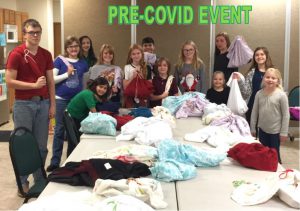
4-H’ers packed pillow case hygiene packs for residents at the Chautauqua Rehabilitation Center.
Service projects are an excellent method of targeting life skills in the “head and heart” areas of the targeting life skills model. Teaching our youth to care about others instills empathy while teaching them the spirit of giving activates community service volunteering. For more ways to volunteer in your county, check with you local 4-H office and seek ways that you can volunteer with 4-H today!
by pmdavis | Nov 10, 2020

Courtesy photo from https://media.defense.gov
When you think of military service, what words come to mind … training, deployments, relocation, freedom, service, and sacrifice? One word that most people overlook is… Family! According to National Child and Traumatic Stress Network “November was first declared as Military Family Month in 1996. Since then, November has been a time to acknowledge the tremendous sacrifices our military families make. They contend with separation from their families and make adjustments to new living situations and communities. Military Families embody strength, resilience, and courage. Care of military families and children sustains our fighting force, and strengthens the health, security, and safety of our nation’s families and communities.”
Help 4-H recognize the Military Family this month. Many of us live in a community with active duty military families, and almost every community has a Guard or Reserve family that you may not realize are service members. These individuals have a different job in the community and serve in times of need.
For those of us without a military background, it can be difficult to know how to be supportive. You may want to meet military family’s needs but don’t know where to begin. Therefore, we have put together a few ideas to help you on your supportive journey.
- Create something decorative to cheer up a veteran’s nursing home room. Picture, Mandala, Bookmark
- If you have a new military family come to your community welcome them to the neighborhood or school. Help them find their way around, give them a list of best places in your community and your phone number in case they need help.
- Leave a care package with family friendly activities and self-care items. Operation Gratitude and Operation Care & Comfort are two organizations that do this for military members.
- Volunteer to babysit or take a child to a practice and give the military parent a break especially if one of the parents is deployed. Just having someone they can trust offer help is a big gift!
- Volunteer your time to provide companionship, serve a meal, assemble holiday packages. Veterans’ advantage has a list of trusted organizations and nonprofits if you don’t have a person in mind.
- Deliver a meal or prepare something that they can take from the freezer and put in the oven or microwave as a quick meal.
- Send a thank you note expressing your appreciation for the family’s support of our Military.
- Offer to cut grass, clean, or help with household chores.
- Offer to run errands – doing a grocery run, picking up dry cleaning, and other errands can ease the burden of juggling responsibilities while a military member is deployed.
- Adopt a family for the holidays. Holidays can be hard when a service member is deployed or doesn’t have family in the local area. Include military families in your holiday plans – holiday dinners, festivals, baking, etc. If you do not have a family locally Soldier Angels can help you to adopt a family.
- Treat a service member or veteran to a holiday stocking filled with items to bring them some cheer. If you don’t have someone in your local area, Soldiers Angels Stockings For Heroes is a national organization doing this. https://soldiersangels.org/holiday-stockings-for-heroes/
- Offer to board a military family’s pet while the family goes on vacation or takes a trip. Dogs on Deployment or PACT Military Foster Program
- Donate to local or national military support programs or gift your airline miles to Hero Miles Program. It supports wounded, injured, and ill service members and/or their families who are undergoing treatment at a medical facility.
We hope you and your family will consider doing something to recognize our military families this month. Also, if you have a family with kids, take them to visit a war memorial and discuss the meaning of service and sacrifice, and that this is something to remind us of the people who served in and died as a result of war. Help them understand the sacrifices of our military families to make our lives better and ensure our basic freedoms. I have been told by friends who are military families that even the “little things” can make a big difference to a military family. Please join us in celebration of National Military Families Month by adopting or supporting a military friend or support organization in 2020.
Written by Jennifer Sims and Paula Davis
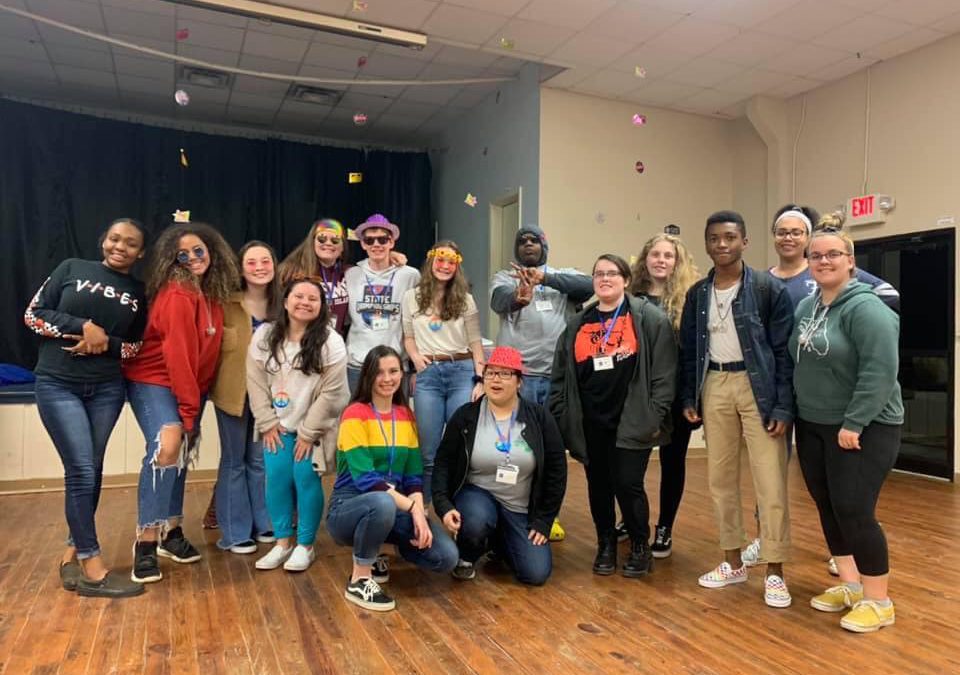
by Allison Leo | Sep 18, 2020
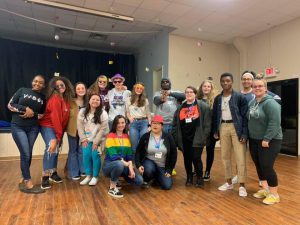
Members from the 2020 Teen Retreat Planning Committee.
The Northwest District Teen Retreat is an event for teens that occurs every year in the Northwest District. The retreat is held at either 4-H Camp Timpoochee in Niceville or 4-H Camp Cherry Lake in Madison. This event is unique because it is planned by the teens who attend! 4-H members age 14 – 18 get to decide on all the major details of the event by attending the Teen Retreat Planning Meetings. During the Northwest District Teen Retreat, a variety of educational workshops, funshops, activities, and a community service project occur. Teens are the main voice in planning the event. The more planning meetings you attend, the more influence you have on the program planning of Teen Retreat.
What Happens During Planning Meetings?
The meetings take place via Zoom allowing you to join from home. 4-H Agents and teen members throughout the panhandle will be on the call. The meetings take place via Zoom and you will have the chance to interact with teens across the Northwest District. The call is guided by 4-H Agents, but the dialogue is led by the teens. Each person in the meeting will have an opportunity to share their ideas and input. Votes take place to decide key items such as the theme, meals, workshop topics, and more. One on of the most important decisions is the t-shirt design. Everyone has an opportunity to submit a t-shirt design and a vote is conducted during the meeting to decide on the design and design colors. Another important decision is what we will eat at meal times and what the evening activities will be. Want to plan a fun event for you and your friends? Attend the Teen Retreat Planning Meetings! Contact your county 4-H Agent If you are not a current 4-H member and you would like to join and attend the Northwest District Teen Retreat.
Why Attend?
When you attend the planning meetings this allows your voice to be heard on how you would like the event to run. Participating in the planning meetings will automatically put you on the Teen Retreat Planning Committee. Participating in the planning committee meetings helps teens increase their leadership skills through their use of organizational skills, decision making, planning, and teamwork. In addition, those who are on the committee will have various leadership opportunities they can take part in throughout the event which can include helping with registration, leading activities, and helping with event set-up, etc.
2020-2021 Planning Meeting Dates
 The Teen Retreat Planning Committee needs active teens to get involved! Teens are encouraged to get involved now in the planning process to give creative input for the 2021 Teen Retreat! So, mark your calendars now and save these very important dates! Committee meetings are held via video conference and can be joined online or by phone. To sign up for this committee, please contact your local 4-H Agent for the call-in information.The meetings are held on the following evenings at 5:30 PM CT/6:30 PM ET
The Teen Retreat Planning Committee needs active teens to get involved! Teens are encouraged to get involved now in the planning process to give creative input for the 2021 Teen Retreat! So, mark your calendars now and save these very important dates! Committee meetings are held via video conference and can be joined online or by phone. To sign up for this committee, please contact your local 4-H Agent for the call-in information.The meetings are held on the following evenings at 5:30 PM CT/6:30 PM ET
- September 29, 2020
- October 20, 2020
- November 17, 2020
- January 12, 2021
- February 9, 2021
To find out more information about 4-H programs or to volunteer with 4-H, please contact your local UF/ IFAS County Extension Office.

by pmdavis | Aug 7, 2020
4-H members and volunteers are always seeking new ideas for hands-on learning experiences as service activities to positively impact our communities. With covid-19, some community service opportunities have been limited due to social distancing and other restrictions. However, the South Atlantic Fishery Management Council and Florida Sea Grant have a new opportunity for 4-H members to get involved virtually. This opportunity is a citizen science project that would be a great way to build your community service hours and learn something new about fish in the process!
Are any of you into history, helping with research, and like fish? If you answered “yes” to any of these, please consider working with the FISHstory Project! The South Atlantic Fishery Management Council and Florida Sea Grant needs help with a citizen science project to help fill gaps in fisheries data using historical dock photos.
Who can participate? Families and youth ages 16+, or younger youth with an adult mentor who is working with them for the sessions. If you are under the age of 16, you will need your parent to register with you. It is a very simple registration process. First, register for FISHstory at https://scistarter.org/fishstory. Then, click on the https://safmc.net/safmc-fishstory/ link to begin helping count and identify fish in the historical photos.
This project will train you as a citizen scientist to identify and count fish using historic fishing photos from the 1940-1970s, prior to when dedicated catch monitoring began. This is a two-part project. The first part is to simply count the number of fish in the photo. The second part is to identify the fish in the photo. Everything is done online using Zooniverse, so there would be no travel or cost to participate in this project.
Data collected with your help will provide a picture of the fishery in the earlier years. This will help scientists understand the fishing industry prior to dedicated monitoring programs. It will also help improve our understanding of the fishing of several iconic species over the years. This data will be used to help accurately estimate stock productivity from 1940 to 1970 when for-hire fisheries off the Atlantic coast of Florida were gaining popularity. Your help is needed to fill these data gaps to help evaluate assumptions about stock productivity. The historic photos, untapped sources of this important biological data, can help do just that. Analyzing the photos will help provide better information of what people were catching during this time period, seasonality of their catches, and possibly estimate a rough catch per angler, which can provide insights on the health of fish populations during that period.
4-H helps youth to learn the skills needed to lead the positive change in their communities like this one. This is done through hands-on learning opportunities that explore citizenship, community development, and personal growth. For more information on community service projects or other 4-H programs that build essential life skills in youth, please contact your local UF IFAS County Extension Office, or visit http://florida4h.org.












